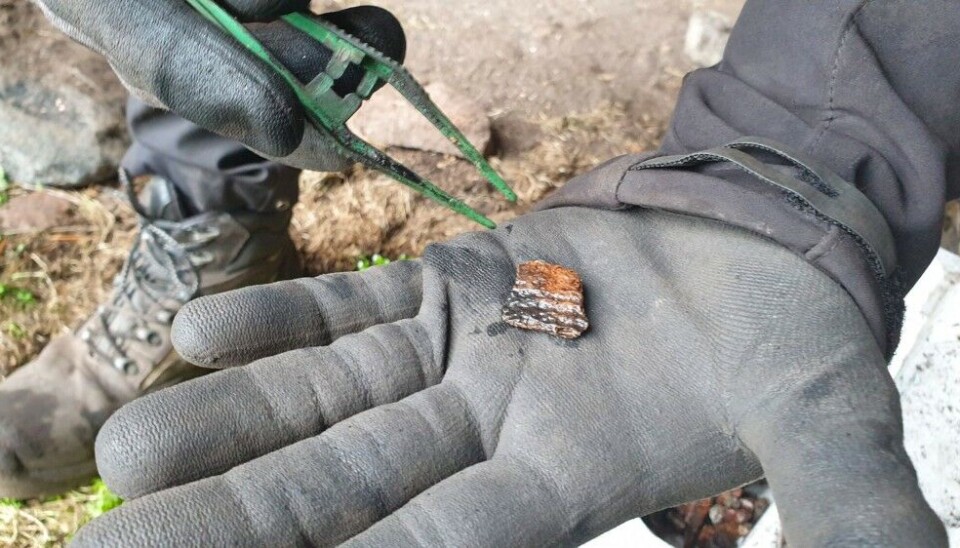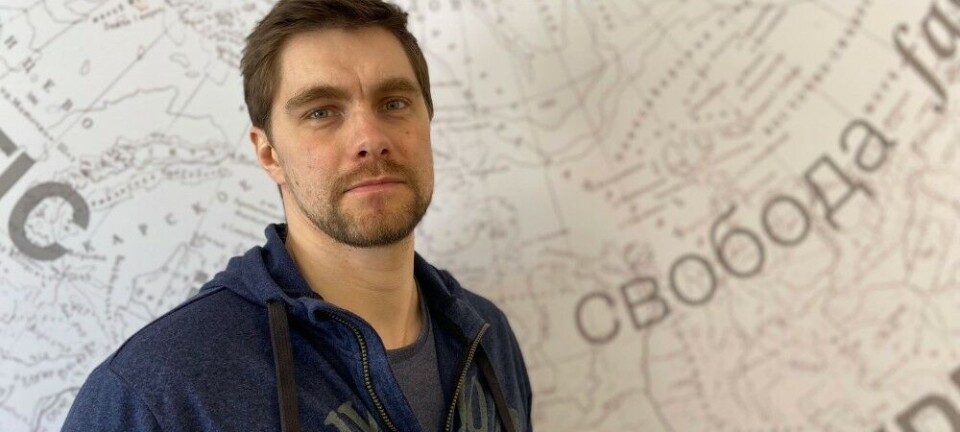
The perfect spot for gatherings for 10,000 years
Exchange of knowledge and expertise, bartering and wooing. Kirkhellaren Cave on Sanna in Træna is Norway’s oldest meeting place, having first been used about 10,000 years ago.
By: Helge M. Markusson, The Fram Centre
So far west out at sea that witty people claim that the gulls here speak English, it is midsummer on the Arctic Circle and we are on the island of Sanna in Træna Municipality. A 10 to 15-minute walk from the quay we find Kirkhellaren, a very famous cave where, throughout repeated ice ages, the frost and sea have carved out a cathedral in a crack of the mountainside.
The cave is 32 metres high and 20 metres wide, with a boulder in the centre that forms a natural altar and has earned it a nickname: “nature’s cathedral”. People have gathered here for at least 10,000 years, making it one of the important meeting places along the Norwegian coast. The enormous cave is perhaps the Norwegian coast’s oldest meeting place.
Says Mikael Fauvelle as he stands in an excavation site in the cave. Fauvelle is a specialist in the interaction between prehistoric hunter-gatherers, and he is an archaeologist at Lund University in Sweden. He is researching the role of movement and mobility in earlier times, and this work has brought him to Træna and the Arctic Circle.

Important finds
Nearby, the project manager Erlend Kirkeng Jørgensen nods in agreement. He has an impressive beard befitting his position as a researcher at the Norwegian Institute for Cultural Heritage Research’s High North Department at the Fram Centre. He oversees the excavation, which is quite spectacular.
“Look here,” says Jørgensen, holding up an object the size of a small stamp. It has come from the excavation site, via sifters and washing dishes.

“These are shards of pottery. You can see that a pattern has been made. We’re down at a level that we date to about 3,000 years ago. Why is this little shard important? Well, the raw materials – the clay and the asbestos minerals used as a thinning agent/binder – and the knowledge of how to convert these into useful objects all come from somewhere else. This shows that there was seasonal migration to and from Træna.
If there was clay around Træna, it would have been so full of salt that it would quickly crack when fired. This means that the clay was brought here, probably from the mainland,” explains Jørgensen. “This summer we’ve found several pits filled with pottery and clay that show that ceramics were produced here in the cave.
A sailing mark
The excavation site in which the researchers have been working this summer has revealed astonishingly large quantities of remains of bones, shells, and burnt wood. This confirms that people have lived here for a long time and that they came here at least 9,000 years ago. At the time, the floodplain stood just outside the cave entrance, and many of the islands visible today lay below the surface of the sea.

The sea was full of seals and fish, so there was food right outside the cave, which in turn provided shelter. This made it a perfect place for people to set up camp.
The meeting place
“There weren’t many people living along the coast, but we know they were mobile. If we compare them with the Inuit in Greenland, we know that they were very mobile. The Inuit used kayaks and umikas and moved all over Greenland. I think the same thing happened here. That’s what I find most fascinating: the people who lived along the Norwegian coast could move with similar boats over very large areas. You must remember that people were not settled in the way that became common later. They followed the resources and seasons, and in that way, they acquired new knowledge. But not only that, people needed to meet, to exchange goods, to acquire knowledge, and to find a partner,” says Fauvelle.
Fauvelle, who has published research on old gathering points in the United States and Mexico, is clear in his opinion that Kirkhellaren has served as a key meeting place along the Norwegian coast.

Seals were important
“And we have evidence that bartering did occur, either in the form of other goods or of knowledge. The shards of pottery show that the people here had acquired the skills to fire clay. Those who lived here hosted visitors and visited other places,” says Jørgensen.
The presence of seals was extremely important here on Sanna. The excavations have uncovered thousands of seal bones and help to underline how great resource seals have been.
“Not only the meat, but also the fat and especially the skins were important. They probably brought sealskins with them as a commodity to exchange. The tools we find most frequently here are various forms of scrapers for processing leather. We have found tools made of flint that were used to prepare seal skins,” says the project manager.
One might call the field that was excavated this summer the cave’s ‘garbage dump’. This was where the people who lived here thousands of years ago threw away the remains of fish, seals, birds, and shells. In addition, the researchers have found cooking pits, fire pits, and large amounts of burnt wood. Further in, a wall has been uncovered that had served as a windbreak.
Changes
Kirkhellaren and its contents have always been subject to changes, both human and climatic. In recent times, the cave has served as an ideal habitat for sheep, which meant that the surface of the cave was covered with a nearly one-metre-thick layer of sheep dung. In 1982, sheep farming on Sanna ceased and the sheep excrement is now gone, and with it a protective layer for the cave’s archaeological treasures. The biggest impacts today are caused by human visitors and leaching. Every year thousands of tourists visit Kirkhellaren, and during the Træna Festival, a concert is held here.
“Given the increased precipitation and warmer winters in our impending future, organic conservation has become an urgent issue. One concrete purpose of the project is to assess how we can best safeguard organic cultural heritage and its unique research potential,” says Jørgensen, adding:
“Coastal resources have been a prerequisite for life since humans first colonised the Norwegian coast. Nevertheless, the exploitation of coastal resources during the Stone Age receives relatively little attention in global research. The reason for this is that there are almost no preserved fragments of human resource exploitation that continuously cover the last 10,000 years. Kirkhellaren is unique in that the meal scraps preserved here date back to an exceptionally early point in history. Reconstructing marine food chains is interesting because humans form part of the ecosystem, and changes in important resource stocks such as fish and seals can be expected to have consequences for human adaptation.”

DNA should provide answers
When the summer fieldwork was over, the excavation area was filled in again, and the cave bottom will gradually return to its previous state. All the samples collected in the course of the work will be the subject of research and subsequent publications.
Among the 11 researchers who participated in this summer’s fieldwork are the PhD candidates Håvard Kjellsen Bjerke, Emma Falkeid Eriksen and Lydia Hildebrand Furness from the University of Oslo. They will later analyse the DNA in bone finds and then compare it with other DNA samples.
The material is so rich that even such small surveys will provide research data for many generations to come.
This story is originally published by the Fram Forum














